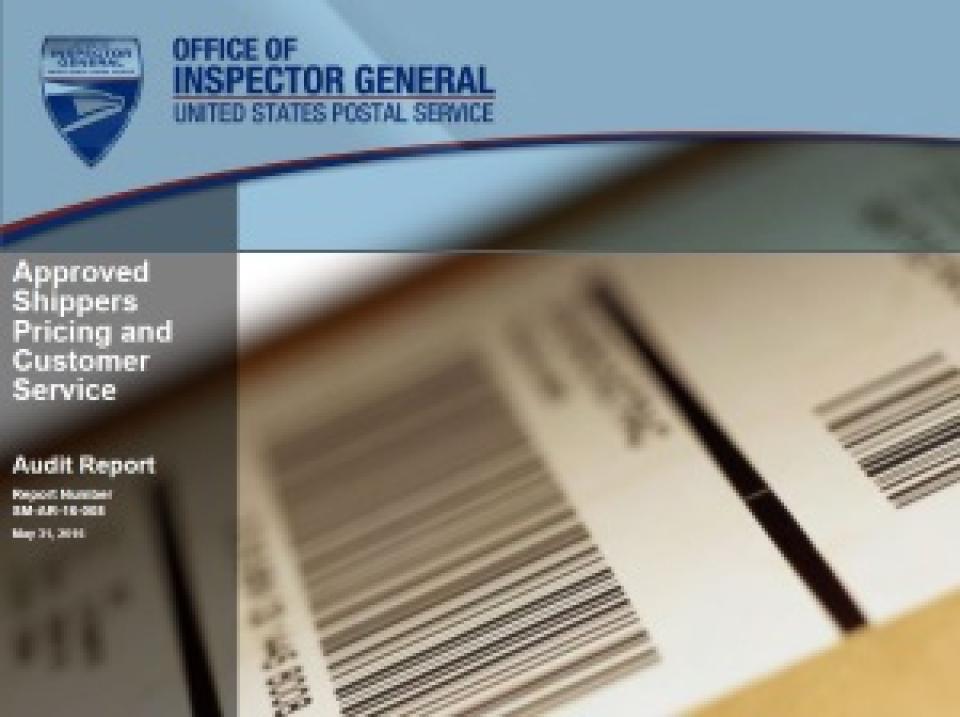Approved Shippers Pricing and Customer Service
Background
The Approved Shipper Program is a component of the Approved Postal Provider® Program, which gives U.S. Postal Service customers expanded access to Postal Service offerings, such as mailing packages and letters, at non-postal locations. In fiscal year (FY) 2015, the Postal Service generated [redacted] from the Approved Shipper Program. As of October 2015, there were 7,860 approved shippers. The UPS Store®, Office Depot®, PostNet, and Staples® are the Postal Service’s largest approved shippers, with 5,065 locations generating [redacted] in revenue during FY 2015.
Approved shippers must charge at least the Postal Service rate for packages but can apply surcharges for accepting mail on behalf of the Postal Service. In addition, the shippers must adhere to the Postal Service’s customer service and safety requirements. A May 2015 U.S. Postal Service Office of Inspector General (OIG) audit report found that approved shippers did not always follow hazardous materials (HAZMAT) and other mail security requirements.
Our objectives were to determine whether approved shippers charged the correct postage when accepting Postal Service mail and assess their customer service standards. We also assessed whether approved shippers improved their adherence to mail security requirements. We conducted our testing at 129 of the four largest approved shipper locations. We did not assess all attributes at each location. Further, we conducted testing at an additional 16 locations to assess the proper handling of certified mail and non-flat rate postage pricing.
What the OIG Found
Approved shippers did not always charge the correct postage when accepting Postal Service mail, and they need to improve their customer service. In addition, shippers are still not complying with mail security requirements.
Approved shippers did not always charge the correct postage for flat rate boxes. Clerks incorrectly quoted lower postage prices at 34 of 90 locations (38 percent) where we presented flat rate boxes. The clerks either quoted a price for the wrong type of flat rate box or priced the flat rate box by weight. Also, clerks at three of 16 approved shipper locations quoted postage prices lower than the Postal Service price for non-flat rate boxes.
Flat rate boxes that are priced below the correct mail category are considered shortpaid, resulting in a net revenue loss to the Postal Service. We calculated that the Postal Service did not realize about [redacted] in revenue during FY 2015 due to shortpaid flat rate boxes accepted by the four largest approved shippers.
Approved shippers also need to improve their customer service:
- Clerks at 64 of 125 locations we visited (51 percent) did not provide correct information about customs declaration form requirements when mailing to Army Post Offices or Puerto Rico.
- Clerks at eight of nine locations where we evaluated certified mail services (88 percent) did not complete the required certified mail form correctly. Four of the nine (44 percent) did not enter the tracking number in their system.
- Clerks at 11 of 129 locations we visited (8.5 percent) made negative or incorrect statements regarding the Postal Service.
By making negative or inaccurate statements about the Postal Service and not following its policy for certified mail and customs forms, the approved shippers could be adversely affecting its brand. If customers do not receive high-quality service at approved shipper locations, they might be deterred from using the Postal Service in the future.
Further, approved shippers are still not following mail security requirements. Ninety of 125 locations visited (72 percent) were willing to accept packages with hazardous materials, such as cologne, lighters, and aerosol sprays. Also, 22 of 129 locations (17 percent) did not secure the mail from public access. Accepting hazardous materials could result in a catastrophic event, potentially harming customers, employees, facilities, and operations. In addition, packages left unsecured could be stolen.
In response to our prior OIG report on approved shippers, Postal Service management established HAZMAT training requirements and approved shippers were responsible for certifying that their clerks were trained annually. However, there was no official test to determine clerks’ level of understanding of the training and approved shippers did not have to re-certify after hiring staff. Additionally, in FY 2016 the Postal Service implemented a new program to improve customer satisfaction by measuring how clerks handle hazardous materials, but it does not focus on mail security or whether clerks apply correct postage to packages.
Without controls to test and verify approved shippers’ knowledge, the Postal Service does not have oversight to ensure the clerks are knowledgeable about the Postal Service’s products and services and understand the importance of its security requirements. We did note that, for 126 of 129 locations visited (97.7 percent), customer wait-time-in-line was 5 minutes or less, exceeding the Postal Service’s goal of a wait-time-in-line of 5 minutes or less 87.5 percent of the time.
What the OIG Recommended
We recommended management update approved shipper license agreements to include provisions for collecting lost revenue and assessing penalties for shortpaid packages; test approved shipper clerks’ knowledge of Postal Service products, services, and HAZMAT requirements; and expand the Retail Customer Experience Program to address correct postage payment and mail security.

